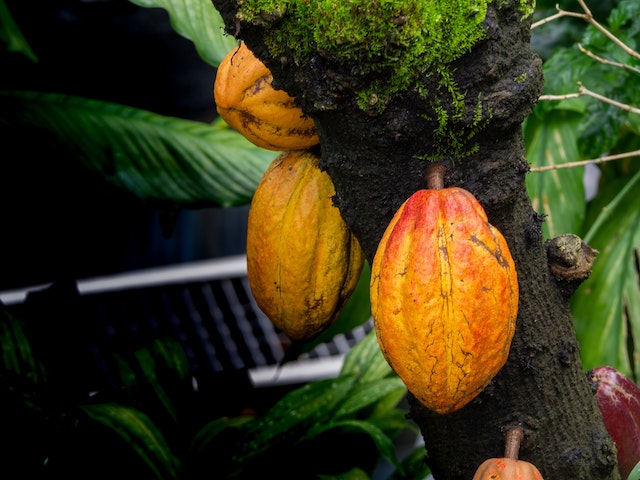
How does cacao become chocolate? Through fermentation, drying, roasting, grinding, and adding milk and sugar.
Cacao beans grow on a cacao tree, which is native to the Amazon basin in South America. The tree is called “Theobroma cacao.” “Theobroma” means “food of the gods” in Greek and “cacao” is the Spanish form of “kakaw” and “kagaw,” which were the names of the beans in Mesoamerican languages. These days cacao trees grow in many places that are hot enough. The Ivory Coast and Ghana are two of the largest cacao producers in the world. This is down to the European colonists that thought it would be profitable to grow cacao in Africa. France and Britain realized that it would be better to grow the cacao in Africa than it would be to take the slaves to the cacao plantations. This is the reason why many African countries are reliant on single crops.
Cacao trees take about three to five years before they can produce the flowers that form cacao pods. Each pod contains approximately 25 seeds, and a tree can produce about 2,500 beans in a year. It takes about 1,000 beans to make a kilogram of chocolate. Once they are ripe, the pods are removed from the tree and cut open. The seeds are white and soft, embedded in a sweet pulp. The first step is to ferment the beans.
Fermentation is a vital part of the process. If the cacao beans are not fermented, the chocolate will not have the same taste and smell. During fermentation, yeasts and bacteria are allowed to grow on the beans and break down the sugars. There are three parts to this. For the first 36 hours, anaerobic yeasts grow. The yeast turns the sugar into carbon dioxide and heat. In the second 36 hours, bacteria produce lactic acid. In the third 36 hours, there is more oxygen and the bacteria start to use the oxygen. A lot of heat is produced and the cell walls of the beans are broken down. The heat and the alcohol produced by the yeast and bacteria also kill the germ (the new plant) inside the seed. Without fermentation, the raw beans taste very bitter and acidic. After fermentation they have more flavor.
Once the beans have been fermented, they have to be dried to remove a lot of the water. They are dried until they only have about 8% water. If the beans are not dried, the fermentation can continue and mold can grow on the beans. Drying makes them more stable and ready for transportation.
The next step is roasting. In the same way as coffee beans, cacao beans have to be roasted to bring out their flavor. They are roasted at temperatures of between 120 and 140℃ for between 30 and 90 minutes. This opens the beans, and it changes them due to the Maillard reaction. Amino acids and sugars inside the cacao beans react, causing chemical reactions that produce the different flavors we find in cacao. The sugar in the cacao beans also caramelizes at high temperatures.
The next step in the process is to grind the beans. Cacao beans contain a lot of fat, about 50% of the bean is fat, and this fat needs to be separated out. The outer shell is removed by a machine, and the inner part of the bean (the nib) is ground into a thick paste. This paste is 50% cacao and 50% cacao fat. Once the paste is made, it is pressed to force out the fat. This fat is the cacao butter. The rest of the cacao is dried, and this is the cacao powder. Both of these are used in making chocolate, but in different ways and in different amounts. The cacao butter doesn’t have any chocolate taste, but it is responsible for the mouth feel of chocolate.
To make most of the chocolate we buy in the shops, sugar, dried milk, cacao powder, and cacao butter are blended in different quantities. The more cacao powder you have, the darker and more bitter the chocolate will be. The more sugar and milk you have, the lighter and sweeter the chocolate will be. Most shop bought chocolate has a lot of sugar and is not that healthy. Cacao in its pure form is very healthy, so the more cacao you can get in your chocolate, the better.
Cacao nibs are very healthy. They have a lot of magnesium, which your body needs for energy and healthy bones. They have a lot of monounsaturated fats, which are good for the heat and cholesterol levels. They have a lot of iron, potassium, protein, and fiber. For their size, they are extremely nutrient-dense. And this is what I learned today.
Photo by KLT Dinusha: https://www.pexels.com/photo/cacao-fruits-on-tree-7450070/
Sources
https://www.scienceofcooking.com/chocolate/how-is-chocolate-made.htm
https://chocolatenaive.com/1469-2/
https://banyantreechocolate.com/pages/chocolate-fun-facts
https://www.ice.edu/blog/cacao-become-chocolate
https://www.ncbi.nlm.nih.gov/pmc/articles/PMC6749277/

Hi! Just wondering- what template did you use for your website? I want to use it on my blog at
Hi. It’s called News Way.